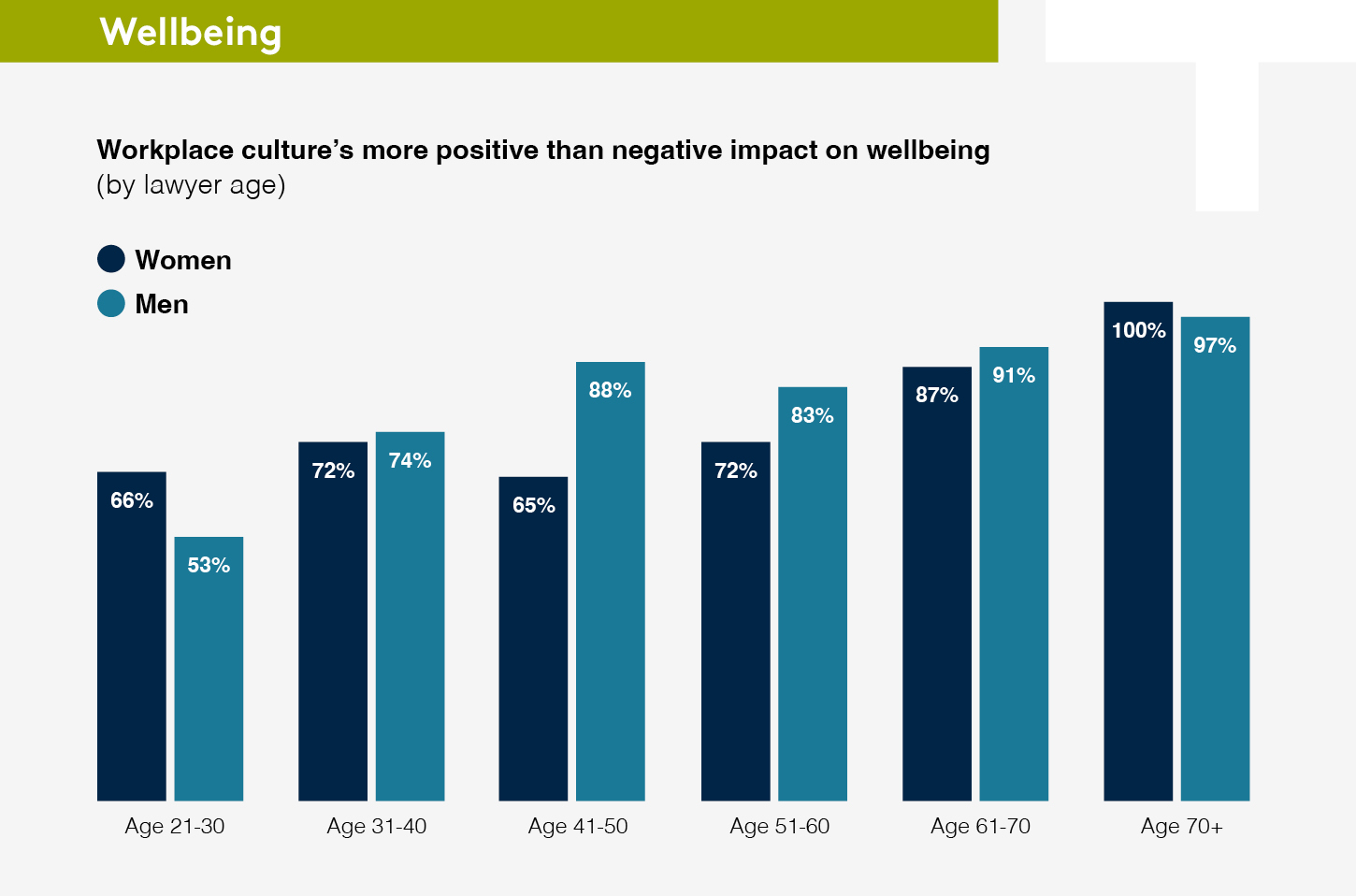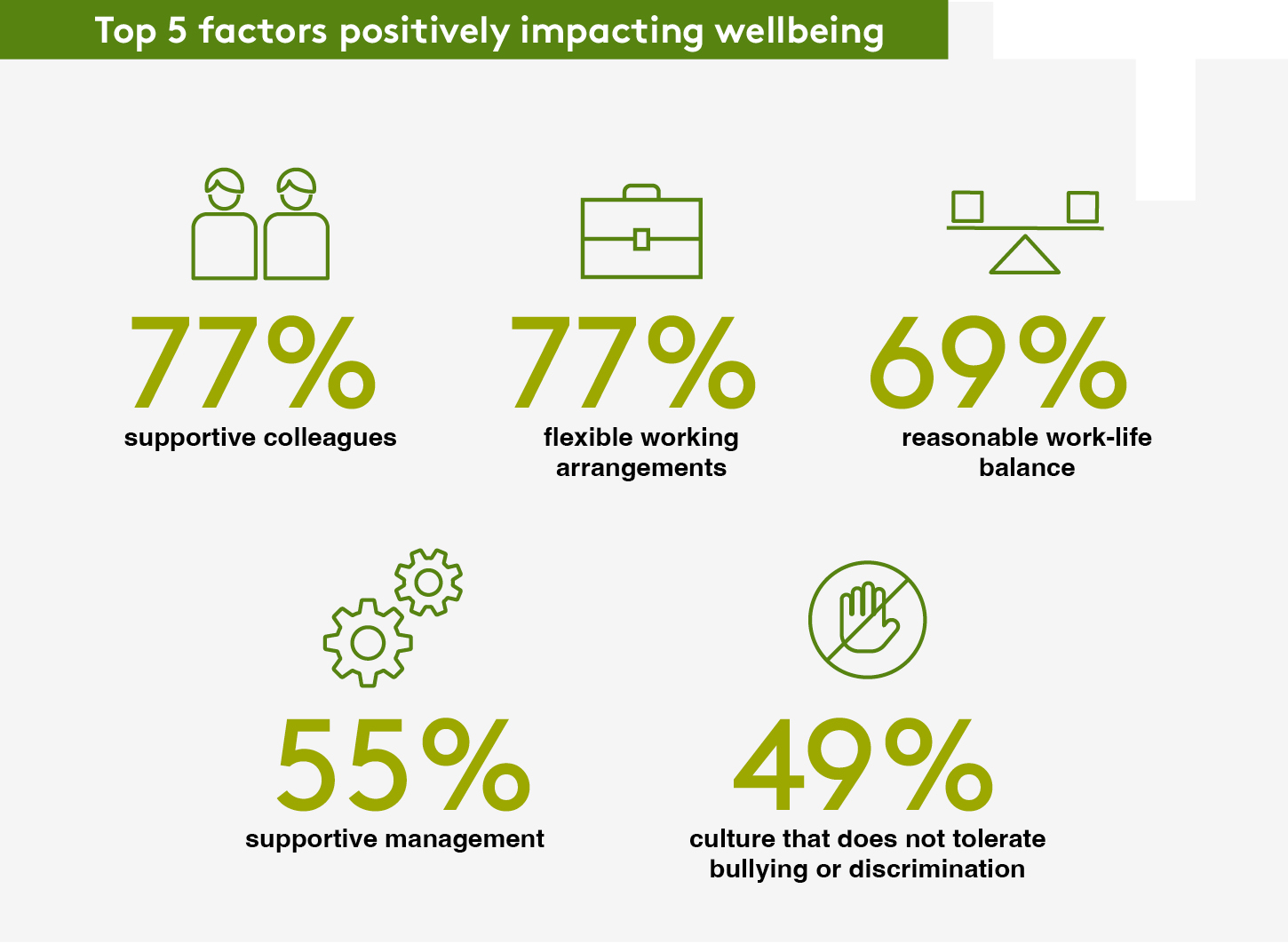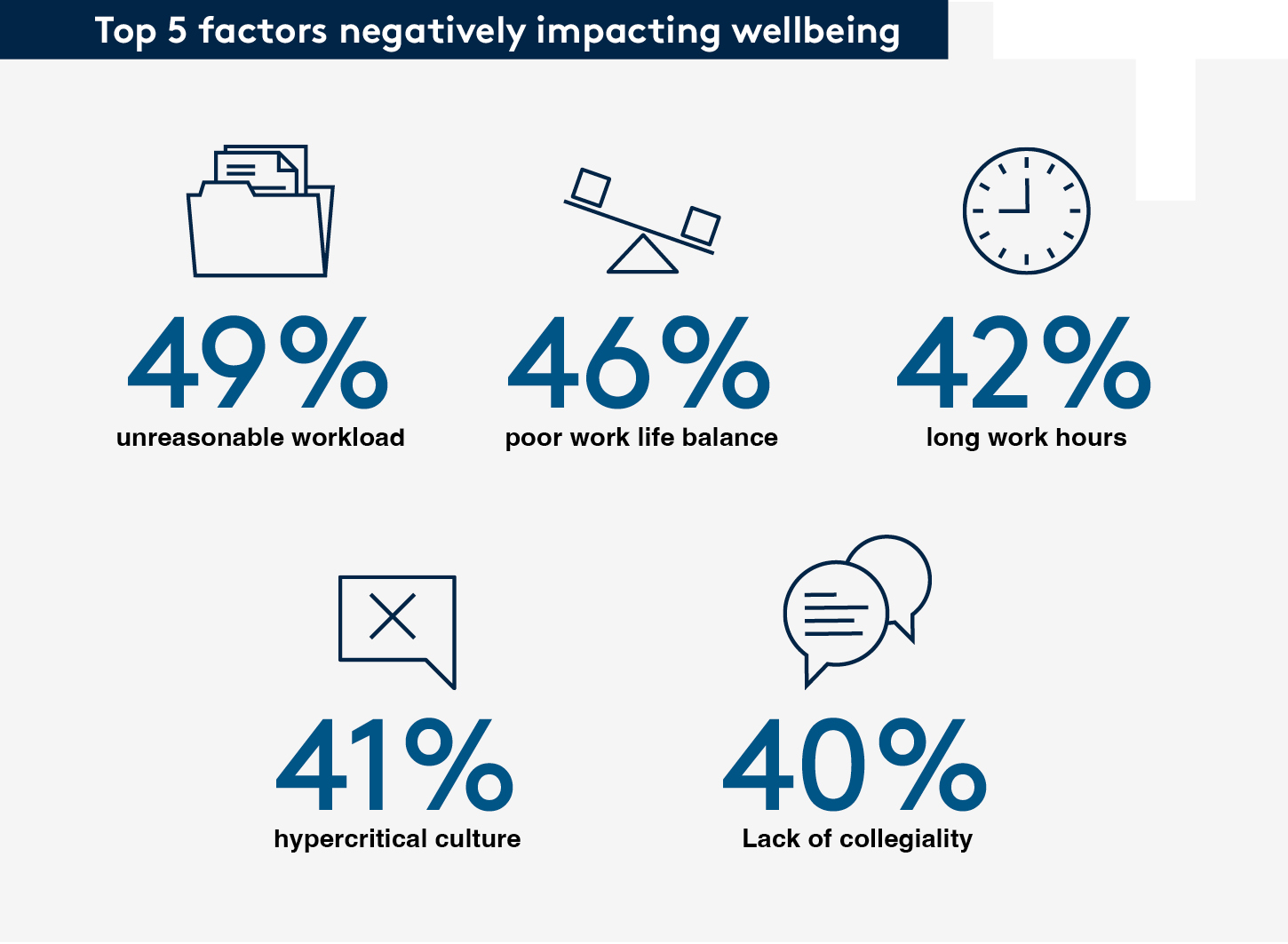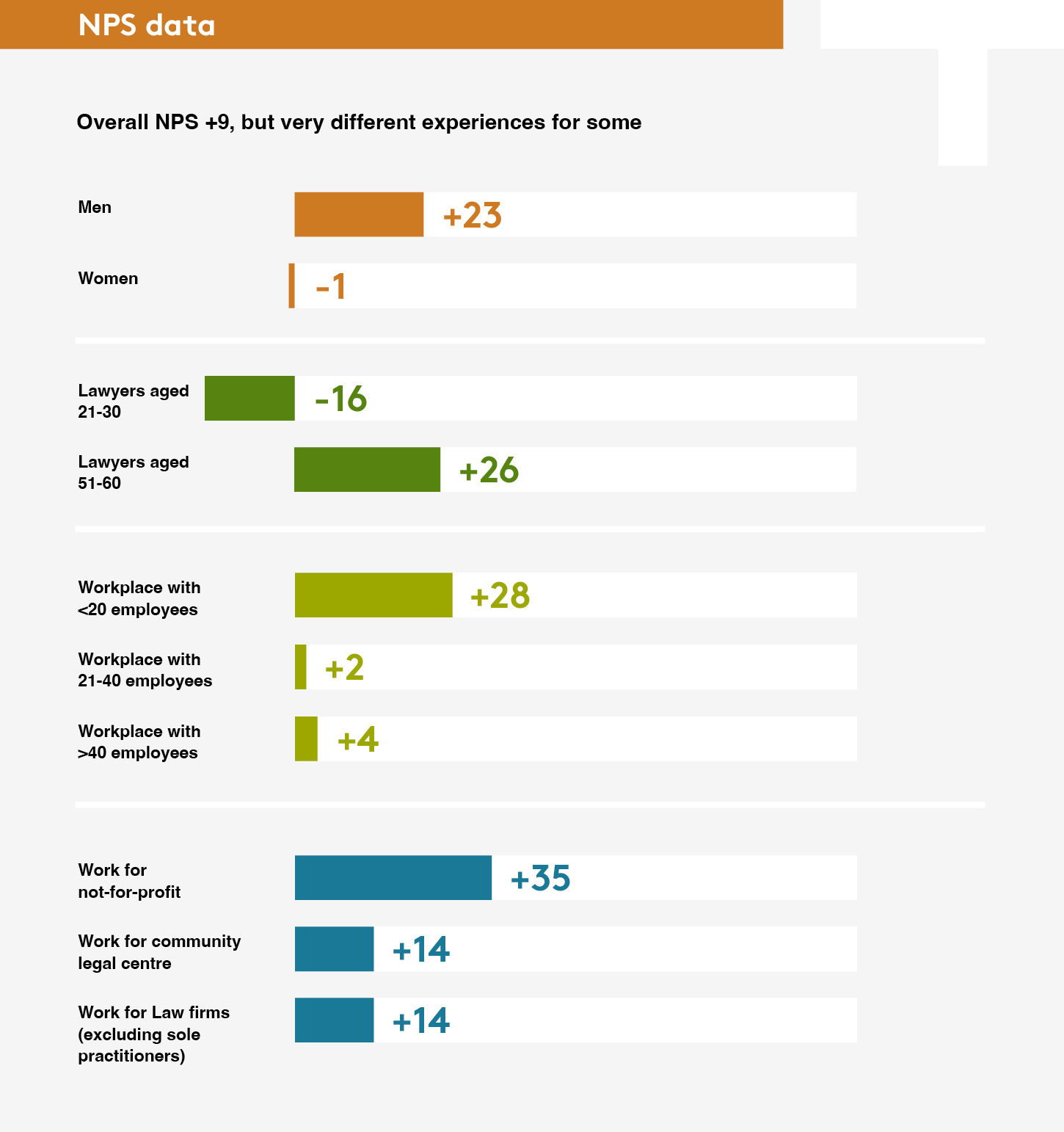Wellbeing is critical for all lawyers, both professionally and personally. The practice of law is an important and rewarding career; poor wellbeing can reduce a lawyer’s sense of satisfaction in their work and contribute to burnout and even to lawyers leaving the profession. At a professional level, poor wellbeing is a barrier to lawyers working ethically and providing quality legal services to Victorians.
To gain a better understanding of how workplace culture affects wellbeing, we asked lawyers to respond to a survey as part of the practising certificate renewal process in 2021.
The survey’s headline results include the positive finding that 76% of respondents said that their workplace culture had a more positive than negative impact on their wellbeing. But when we dug a little deeper into the findings, it became clear that lawyers’ experiences are not consistent and there remain key areas of concern – particularly for women and younger lawyers.
Impact of workplace culture on wellbeing
Respondents were asked whether their workplace culture had a more positive or a more negative impact on their wellbeing overall.
While 76% said that their workplace culture had a more positive than negative impact on their wellbeing overall, there was a noticeable difference in results when we considered the findings based on lawyers’ age and gender, as shown in the graph below.

Responses indicating that the workplace culture had a more positive than negative impact on wellbeing for lawyers is reflected by a bar graph, divided by men (light blue) and women (dark blue) across different age groups as follows:
- Age 21 to 30: responses were 66% Women and 53% Men
- Age 31 to 40: response were 72% Women and 74% Men
- Age 41 to 50: responses were 65% Women and 88% Men
- Age 51 to 60: responses were 72% Women and 83% Men
- Age 61 to 70: responses were 87% Women and 91% Men
- Ages over 70: responses were 100% Women and 97% Men
Overall, almost one in three (29%) women reported that their workplace had a more negative impact on their wellbeing, compared to 17% of men. The biggest gap between genders occurred with people aged 41-50, where 35% of women reported their workplace culture had a more negative impact, compared to 12% of men.
Respondents from the younger age brackets were also more likely to report that their workplace culture had a more negative impact on their wellbeing, compared to older lawyers.
Sole practitioners had the highest proportion (89%) of respondents who reported that their workplace culture had a positive impact on their wellbeing overall, followed by the Bar (85%) and not-for-profit organisations (85%).
Respondents who work in Melbourne (CBD-77% and suburban Melbourne-79%) had better experiences of wellbeing in their workplaces, compared to lawyers who work in country Victoria (69%).
While some male and female early-career lawyers expressed more negative responses, the responses from men generally became more positive as they progressed in their careers. In contrast, the survey results indicated women are more likely to experience negative impacts of workplace culture on their wellbeing as they enter the mid-stage of their legal careers.
Positive factors that contribute to wellbeing
When asked about the factors that contribute positively to their wellbeing, the most commonly cited factors were supportive colleagues, flexible working arrangements, work-life balance, supportive management and a culture that does not tolerate bullying or discrimination.

Information on the infographic shows the top five factors positively impacting wellbeing selected by lawyers which include:
- Supportive colleagues at 77%
- Flexible working arrangements at 77%
- Reasonable work-life balance at 69%
- Supportive management at 55%; and
- culture that does not tolerate bullying or discrimination at 49%
These findings show lawyers value positive relationships with their colleagues and being able to balance their working life with their broader responsibilities, commitments and interests. They also point to the value of good leadership, adaptability and empathy when managing lawyers.
Negative factors that impact wellbeing
In contrast, unreasonable workloads, poor work-life balance, long work hours, a hypercritical culture, and a lack of collegiality were identified as the most common factors contributing to negative experiences of wellbeing.

Information on the infographic shows the top five factors negatively impacting wellbeing selected by lawyers which include:
- Unreasonable workload at 49%
- Poor work life balance at 46%
- Long work hours at 42%
- Hypercritical culture at 41%; and
- lack of collegiality at 40%
Unreasonable workload, work-life balance and long work hours were in the top three factors for both men and women. Many of the other negative impacts identified by women pertained to ‘cultural’ issues within the workplace. For example, women more commonly selected negative factors such as hypercritical culture, valuing profit at the expense of people, and bullying.
For younger lawyers (aged 21-30 years), lack of training and professional development was the most commonly reported negative factor (61%). Unreasonable workloads were also more of an issue for lawyers aged 21-50 (ranging from 54-64%) compared to those aged 51-70 (ranging from 22-36%).
Employee sentiment
To gauge employee sentiment, we asked how likely they are to recommend their employer as a place to work (on a scale from 1-10) and we used the results to derive a Net Promoter Score (NPS).
Overall, respondents gave a NPS of +9, which means they were a little more likely than not to recommend their employer as a place to work. However, when we looked at the responses by age and gender, the story changed.

Information on the infographic shows the Net Promoter Score (NPS) results broken down by overall gender, selected age groups, number of employees within the workplace, and category of the law practice. The overall NPS result was plus 9, but scores were very different based on the experiences for some as indicated:
- By gender, Men had an overall score of plus 23, while women had an overall score of minus 1
- By age groups, those between the ages of 21 and 30 had an overall score of minus 16, while those between ages of 51 and 60 had an overall score of plus 26
- By the number of workplace employees, workplaces with less than 20 employees had an overall score of plus 28; and workplaces that have between 21 and 40 employees had an overall score of plus 2; and workplaces that have more than 40 employees had an overall score of plus 4
- By category of law practice, those that work for not-for-profit had an overall score of plus 35; and those that work for a community legal centre or law firm (excluding sole practitioners) had an overall score of plus 14.
Men were much more likely than women to recommend their employer as a place to work. Similarly, older lawyers were much more likely to do so than younger lawyers. This reflects both cohorts’ generally more positive wellbeing experiences at work.
The size and type of organisation also had an impact on employee sentiment. Lawyers who worked in organisations with fewer than 20 employees were more likely to recommend their employer than those who work in larger organisations. Lawyers who worked at a not-for-profit were significantly more likely to recommend their employer.
Some observations
Our findings show there are different workplace cultural challenges for lawyers, based on gender and age. The diversity, sustainability and safety of our profession depends on our ability to address these issues for everyone.
So what can we do? Firstly, we need to continue to change attitudes to how we think about and respond to these challenges. We also need to look at diverse solutions to these complex problems, and how these can be tailored to the experience of each group. And finally, we need to invest in training and developing our people.
Looking at the factors that influenced responses, women (across the age brackets) were more likely to report negative impacts relating to workplace cultural factors. This remains a key challenge for employers and managers – and one that needs to be addressed in a way that reflects diverse experiences.
Another concerning finding is that many younger respondents (21-30 years) reported that their workplace culture had a negative impact on their wellbeing, which was reinforced by that group’s comparative reticence to recommend their employers. The dominant negative factors for younger lawyers were inadequate training/PD opportunities (61%), unreasonable workload (58%) and poor work-life balance (48%). There is likely a relationship between these impacts, given that work is generally harder and takes longer without adequate training, which in turn affects work-life balance.
These findings echo those in our Lawyer Wellbeing Project, in which early career lawyers reported that they lacked training in certain areas, including interpersonal and coping skills, and described negative early career experiences, including very long work hours.
Notably, half (49%) of all respondents who reported that their workplace culture had a more positive than negative impact on their wellbeing cited their workplace’s response to COVID-19 as one of the reasons for that response. This was a reassuring result given how the disruptive the pandemic has been to all of our lives.
The responses to this survey by type, size and location of employers also suggest there is positive impact on wellbeing where lawyers have a high degree of control over their work, work in a smaller, more personal environments and have access to professional support.
It is important for all Victorian lawyers – and particularly those in leadership roles – to read these findings and join us in considering what they can do to contribute to improving wellbeing in our profession. After all, lawyer wellbeing is everyone’s responsibility.
About the lawyers surveyed
About 3.5% of lawyers responded to our survey, which provides results that are statistically significant within a margin of error ±5%, at a 95% confidence level. This means that if, for example, we found that 50% of legal practitioners reported that their workplace culture has a more positive than negative impact on their wellbeing overall, we would be 95% confident that, had we received responses from the whole legal profession, the actual result (i.e. across the whole profession) would be somewhere between 45% and 55%.

Information on the infographic (stacked bar graph) shows the number of Victorian lawyers that completed the survey broken down by gender, location, age, and position. A total of 881 Victorian lawyers completed the survey. Of the total:
- 58% were women; 41% were Men, and 1% identified as other gender identities.
- For location, 73% were lawyers that work in the CBD, and 20% work in the Melbourne suburbs, and 7% work in regional Victoria.
- For Age, 12% were between the ages of 21 and 30; 24% between the ages of 31 and 40; 24% between the ages of 41 and 50; 23% between the ages of 51 and 60; 12% between the ages of 61 and 70; and 5% over the age of 70.
- For position, 38% were practitioners in law firms; 14% in Corporates; 14% at the Bar; 10% in State Government; 7% in Statutory Bodies; 7% working as sole practitioners; 4% in Community Legal Centres (CLC); 3% in the Commonwealth Government; and 3% in Not-for-profit (NFPs).
Further resources
To help improve the wellbeing of the legal profession the VLSB+C is taking an active role in championing cultural change through its regulatory work, wellbeing resources and wellbeing projects. You can access our wellbeing resources here.